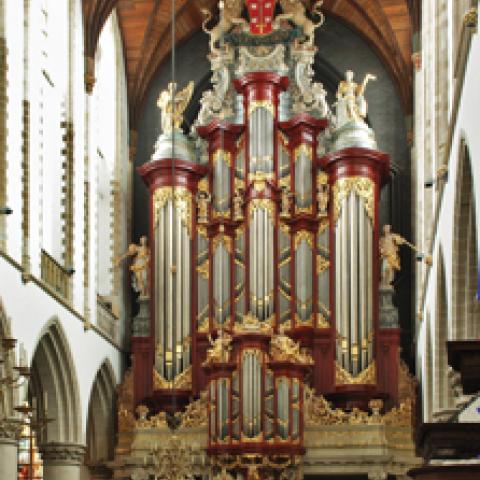Gerben Mourik has been chosen unanimously by the jury as the winner of the 47th International Organ Improvisation Competition held in the historic town Haarlem in the Netherlands. It was the third time Gerben Mourik participated in the competition, and he had already reached the finale once before. In both the forst two rounds as at the finale he was given the highest ratings by the jury.
The audience award fell to the German candidate David Franke. The other finalists were David Cowen (UK) and Jean-Baptiste Dupont (France). The four contestants each improvised on a theme composed by Ig Henneman.
The jury members are the well-known organ-improvisors Peter Planyavsky, Thierry Escaich and Ansgar Wallenhorst, composer Jan Welmer, jazz-pianist Bert van den Brink and chairman organist Stephen Taylor.
Gerben Mourik (1981) studied organ with Ben van Oosten and improvisation with Ansgar Wallenhorst and Naji Hakim. He won the National Improvisation Competition in Zwolle in 2003 and was a finalist at the International Improvisation Competition in Haarlem in 2004. In 2005 he won the Improvisation Competition in St Albans (UK). He is organist in Oudewater and performs regularly as both soloist and accompanist.
The audience award winner David Franke (Freiberg/Saxony,1980) was a member of the ‘Dresden Kreuzchor’. He studied organ and church music in Stuttgart as a pupil of Ludger Lohmann, Hans Martin Corrinth and Jürgen Essl. David Franke is currently a student of Leo van Doeselaar and Wolfgang Seifen in Berlin.He has been a finalist in theimprovisation competitions at Haarlem (2006) and St Albans (2007).
During the competition participants had to improvise convincingly themes on both the Christian Müllerorgan at the Haarlem Grote of St. Bavochurch, and on the Cavaillé-Collorgel of the Haarlem Philharmonie.
Amongst the ten participants of the competition this year five dutch candidatesparticipated. In the past years interest for organ-improvisations in the Netherlands appeared to be diminishing, but the and high level of current contestants and the winner proves otherwise, a new generation of organ improvisers is on its way!
On Friday evening July 18th the jury will perform themselves with improvisations on organ and grand piano.
The competition is part of the International Organfestival, Haarlem, the Netherlands. The festival will continue until August 2nd. The festival has attracted a great deal of attention and an unexpected high number of visitors. The coming weeks there will be more classical- and contemporary concerts and lectures and also the International Summer Academy for professionals world wide.
During the festival the coming weeks amongst others performaces of : Olivier Latry, organplayer at the Notre Dame in Paris, with Messiaens Le Livre du Saint Sacrement , and interpretation concerts around Messiaen en Sweelinck . Also contemporary composers and cross-overs with a jazzconcert by hammond-organplayer Rhoda Scott.There are several lectures a.o. Bachspecialist Prof. Dr. Christoph Wolff.
More information and updates at www.organfestival.nl
Ticket info VVV Haarlem: 0900 - 61 61 600, www.vvvzk.nl
Rervations: St Bavo tel: 023 - 553 20 40, info@bavo.nl
This festival is supported by : Ministerie van Onderwijs, Cultuur en Wetenschap en Gemeente Haarlem and Prins Bernhard Cultuurfonds, SNS Reaal fonds en Thuis Kopie Fonds.
Photo credit: Sonja Heimann.





